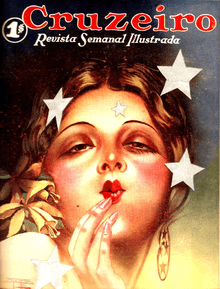O Cruzeiro
O Cruzeiro was a Brazilian illustrated weekly magazine, published in Rio de Janeiro from 1928 until 1985, with the exception of the period from August 1975 to June 1977.
 Cover of O Cruzeiro's first issue (1928) | |
| Editor | Alexandre von Baumgarten |
|---|---|
| Former editors | Carlos Malheiro Dias Accioly Neto José Amádio |
| Categories | News magazine |
| Frequency | weekly |
| Publisher | Diários Associados |
| Founder | Assis Chateaubriand |
| Year founded | 1928 |
| First issue | 10 November 1928 |
| Final issue | July 1975 |
| Country | Brazil |
| Based in | Rio de Janeiro |
| Language | Portuguese |
History and profile
The first edition was released with 70 pages on 10 November 1928 and was published by Empresa Grafico Cruzeiro S.A. of Dr. José Mariano Filho in 152 Rua Buenos Aires. The publication, subtitled Revista Semanal Illustrada, was until 1933 under the directorship of Carlos Malheiro Dias who was succeeded by Antonio Accioly Netto.[1] The leading Brazilian illustrated magazine in the first half of the 20th century was over long stretches under the stewardship of Diários Associados owned by Assis Chateaubriand .[2]
O Cruzeiro established a new language in the Brazilian press: graphic innovations, publishing great articles, with emphasis on photojournalism.[3] It strengthened the partnership with reporter-photographer duos, the most famous being formed by David Nasser and Jean Manzon who in the 1940s and 1950s produced stories of great impact.[4] The magazine made it clear in its first editorial that it differed from its "older sisters who were born from the debris of Colonial Rio", putting itself at the forefront of modernity combining its name to modern technology: "O Cruzeiro will find in its birth the skyscraper, the radio, and the air mail ".[5][6]
In 1941, O Cruzeiro also became the name of the publishing house of the Diários Associados group.[7]
Among its many subjects, the magazine O Cruzeiro told facts about the lives of stars, cinema, sports and health. It also had sections of cartoons, politics, cooking and fashion.
Covering the suicide of Getúlio Vargas in August 1954, the magazine circulation reached 720,000 copies. Until then, the maximum reached was the mark of 80,000 copies. Thereafter, the number remained. In the 1960s, O Cruzeiro declined. This was also caused by the emergence of new publications such as Manchete and Fatos & Fotos. The end of the empire of Chateaubriand's Diários Associados caused a hiatus between mid 1975 and September 1977, when o Cruzeiro returned under the leadership of Joaquim José Freire Lagreca.
Collaborators
Some of the most notable collaborators to the magazine were:[1][8]
- Carlos Estêvão
- David Nasser
- Gustavo Barroso
- Jean Manzon
- José Araújo de Medeiros
- José Cândido de Carvalho
- José Leal
- Luciano Carneiro
- Mário de Morais
- Millôr Fernandes
- Péricles
- Rachel de Queiroz
- Ubiratan de Lemos
- Ziraldo
References
- Accioly Netto (1998). O Império de papel- os bastidores de O Cruzeiro (in Portuguese). Porto Alegre: Sulina. p. 166.
- Marcello Rollemberg (2012). "An update on Brazilian publishing history". São Paulo: Matrizes. Retrieved 6 August 2015.
- Scalzo, Marília (2003). Jornalismo de revista (in Portuguese). São Paulo: Contexto. p. 30.
- Carvalho,Luiz Maklouf (2001). Cobras criadas-David Nasser e O Cruzeiro (in Portuguese). São Paulo: Senac. p. 599.
- "Editorial". O Cruzeiro. 1 (1): 3. 10 November 1928.
- Carvalho,Fabio Reynol de (2011). Ciência de Almanaque: como as imagens de Eu Sei Tudo construíram uma guerra (PDF) (Master's dissertation). Campinas: Universidade Estadual de Campinas. Retrieved 27 May 2013.
- Jacques Alkalai Wainberg (2003). Império de palavras. EDIPURS. p. 169. 9788574303765.
- Enciclopédia Barsa universal. 5. São Paulo: Barsa Planeta. 2007. p. 1709.
External links
- O Cruzeiro at Memória Viva (in Portuguese)